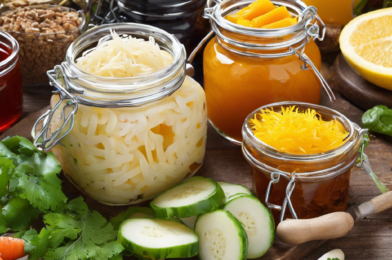The world of gut health and nutrition is an ever-evolving field, with new research constantly shedding light on the complex relationship between our diets and our digestive wellbeing. Among the myriad of dietary advice and trends, one practice has stood the test of time and is gaining traction for its potential health benefits – fermentation.
Fermented foods have been a part of human diets for centuries, with almost every culture boasting its own traditional fermented treats. From Korean kimchi to German sauerkraut, and Indian dosas to Ethiopian injera, fermentation has been used as a way of preserving food and adding flavor to our meals. But beyond its culinary applications, fermentation has been linked to a host of potential health benefits, particularly when it comes to our gut.
So, what exactly happens during fermentation? It’s a natural process that involves the transformation of carbohydrates, such as sugar, into organic acids or alcohol through the activity of microorganisms like bacteria or yeast. This process not only preserves the food but also creates a host of beneficial compounds, including probiotics.
Probiotics are live microorganisms that, when consumed in adequate amounts, offer health benefits to the host. They are often referred to as ‘good’ bacteria and are believed to play a crucial role in maintaining a healthy gut microbiome – the diverse population of microorganisms that reside in our digestive tract.
A balanced gut microbiome is linked to improved digestion, stronger immune function, better mental health, and a reduced risk of certain diseases. By introducing beneficial bacteria through fermented foods, we may be able to support and promote this delicate balance, contributing to our overall health and wellbeing.
Fermented foods are powerful sources of probiotics, offering a diverse range of bacterial strains that can survive the journey through our digestive system and take up residence in our gut. This process may help increase the number and diversity of beneficial bacteria in our microbiome, creating an environment that supports digestive health and may even contribute to weight management and improved cardiovascular health.
One of the most well-studied fermented foods is yogurt, which has long been a breakfast staple and snack for health-conscious individuals. However, the world of fermented foods goes far beyond dairy. Vegetables, fruits, grains, and beans can all be fermented, offering a wide variety of flavors and textures to explore.
Kimchi, for example, is a spicy Korean side dish made from fermented cabbage and a range of seasonings, providing a crunchy and flavorful addition to meals. Kombucha, a fermented tea, has gained popularity in recent years and can be found in a variety of flavors, often serving as a healthier alternative to sugary drinks.
Including fermented foods in your diet is an excellent way to support your gut health and overall wellbeing. The variety of options available means that you can find flavors and textures to suit your taste, and with the potential health benefits on offer, it’s worth exploring this ancient practice and incorporating it into your modern diet.
So, how can you incorporate more fermented foods into your diet? It can be as simple as adding a spoonful of sauerkraut to your sandwich or salad, swapping your morning juice for a bottle of kombucha, or enjoying a bowl of miso soup as a starter. With small additions and adjustments, you can easily unlock the potential benefits of fermented foods and support your gut health.
Remember, when introducing any new food to your diet, it’s important to start slowly and observe how your body reacts. While fermented foods are generally safe for consumption, everyone’s gut is unique, and you may find that some varieties or amounts work better for you than others. Pay attention to how you feel and adjust your intake accordingly.
Additionally, when purchasing fermented foods, opt for unpasteurized or raw options whenever possible. Pasteurization is a heat treatment that kills harmful bacteria, but it also destroys the beneficial bacteria we’re aiming to consume. Look for products that specifically mention ‘live cultures’ or ‘raw’ on their labels to ensure you’re getting the full potential of the fermentation process.
By exploring the world of fermented foods, you’re not only treating your taste buds to new flavors and textures but also nurturing your gut health and supporting your overall wellbeing. So, embrace the ancient practice of fermentation and enjoy the potential benefits that come with each delicious bite or sip.









